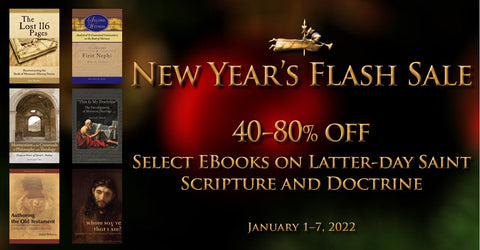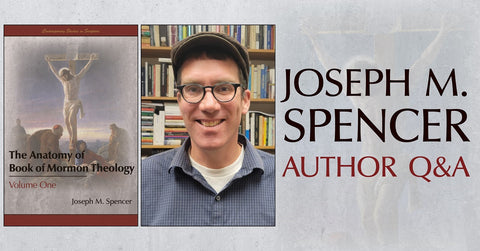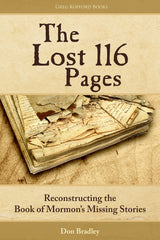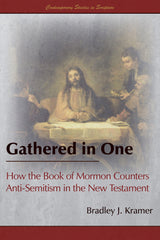A: Well, in a lot of ways, to answer that question would be to tell you my whole story! The two volumes of Anatomy collect essays I wrote between about 2008 and about 2018, a decade of work on the Book of Mormon. The earliest several were my very first forays into writing theologically about the Book of Mormon. Other essays came at different points over the course of a decade. Taken together, they punctuate the story of my own coming of age as a Book of Mormon scholar. When I set out to write about the Book of Mormon, I don't think it could be said that there was such a thing as Book of Mormon theology---certainly not as a recognizable field! Ten years later, I could say I had an intellectual home as a Book of Mormon theologian. It was while I was writing that this approach to the Book of Mormon began to take shape. I watched that happen, contributing what I could. And so Anatomy is something like an archive that documents one scholar's perspective, witnessing something new be born.
That's not it, though. What I slowly figured out how to articulate for and to myself over the course of that decade was what it means even to speak of Book of Mormon theology. What does it mean to do theology with the Book of Mormon? My earliest essays found me beginning to work out an answer to that question, even though I didn't know I even had that question. As time went on, and as I found myself with a variety of interesting interlocutors (not all of whom were doing theology, to be clear!), the question itself, along with my answer (or answers!) to it, became clearer to me. And so Anatomy is divided up into essays I wrote that help to articulate the various ways one might go about doing theology with the Book of Mormon.
Q: Can you explain what you mean by “the anatomy” of Book of Mormon Theology?
I settled on this title only eventually, but I hope it captures something important. I like the idea that Book of Mormon theology is a living thing, with a lot of deeply interconnected parts. The word "anatomy" is privative—that is, the "an-" at its beginning means "not." The word applies to things where it's inappropriate to speak of smallest units, of "atoms" (in a sense different from the way we talk about atoms in modern physics, obviously). Anatomy is at issue wherever we can't break something down into fully separable building blocks, where there's something organic about the thing that requires us to see how a massively complex living thing can't be taken apart without depriving it of life. Book of Mormon theology feels to me like that. It isn't the sort of thing we could just break down into a few fundamental topics (the nature of God, how the Spirit works, what salvation means, etc.) or a few fundamental approaches (philosophical theology, pastoral theology, historical theology, etc.), hoping then to put them back together into some kind of whole.
It's for this reason precisely that it's useful simply to look at a dossier of theological essays, a set of productions emerging on so many different occasions over the course of a decade. I couldn't ever have begun with some overarching vision of what all had to be done, theologically, with the Book of Mormon and then simply executed the program. Different interests and various concerns had to draw the theological relevance of the Book of Mormon out of me while the project was feeding, breathing, growing. But looking back over things after ten years of work, I find it possible to start to give names to different systems of thought---to different organs in this living body, so to speak---and so to make some sense of things. It becomes especially clear to me where the center of the body lies, where the heart is that's pumping life-giving oxygen to everything else. And that's something I hope comes clear to every reader of these volumes.
Q: For those less familiar with theology, can you offer a basic definition?
I'm always hesitant to give theology a strict definition—for all the reasons I've been talking about already! At the very least, though, someone does theology when she takes the demands of reason as seriously as possible while nonetheless always ultimately submitting them to what God reveals. When someone does theology with the Book of Mormon, then, she has to do a number of things. She can't just read the Book of Mormon quickly, assuming that she understands the meaning of the text. She has to do (or at least borrow from) intense interpretive work, sorting out the way the book is organized, how its story unfolds, what its various prophecies and sermons and narratives have to say, and so on. She also has to do (or at least draw on) good philosophical work, of a sort that probes beneath the surface of things and makes them more interesting than we often take them to be. With the real depth of the Book of Mormon on display, and with the best thinkers as her interlocutors, she might begin to let the Book of Mormon speak in a richly theological way.
That's not very basic, I'm afraid. It's also probably the best I can do. It's no simple thing to do theology, and to do it well. We have to get far more serious than we usually are about what the Book of Mormon itself has to say, in its own name. And we have to get far more serious than we usually are about ideas in general. Then theological work on this sacred text begins in earnest. And I should note, then, that doing theological work on the Book of Mormon is rather different from studying the book doctrinally or with an eye to application, although it's related to both of these things. To study the Book of Mormon doctrinally is to look at how the book clarifies the official doctrines of the Church. To study the Book of Mormon with an eye to application is to ask how its words might immediately shape my everyday life. These are questions I might be asking when I do theology as well, but they don't need to be.
Q: How are the two volumes organized?
The first volume of Anatomy gathers essays that I think fit most easily into traditional notions of what it would mean to do theology with a book of scripture. It's worth saying that, along with a handful of colleagues, I labored over the years covered in these two volumes on developing a rather novel approach to doing theology with scripture---and with the Book of Mormon in particular. We didn't set out with the idea of doing any such thing, but that's what indeed happened. Along that peculiar pathway, however, I took plenty of opportunities to write more traditional theological essays as well. It's those that make up most of the first volume of Anatomy. That first volume comes, in fact, in four parts. The first handful of essays represent my earliest forays, which I gather under the title "Halting First Steps." A second handful of essays explore a variety of resources for doing theology in whatever fashion. These appear under the title "Running toward Theology." And then there are two gatherings of essays titled "Traditional Theology": a first gathering of essays specifically focused on the atonement of Jesus Christ, and a second gathering of essays focused on a variety of theological topics, approached in a way anyone might expect.
The second volume of Anatomy turns to the kinds of theological work I and others developed over the course of a decade. It opens for that reason with a transitional essay, a reflection on theological method. There then follow two gatherings of essays in each of two novel theological styles, to which I give the respective names of microscopic and macroscopic theology. Most of the examples of microscopic theology grew directly out of my work with Adam Miller and others in the Latter-day Saint Theology Seminar (what used to be called the Mormon Theology Seminar). There we forged a style of excruciatingly acute analyses of scriptural texts, put in the service of theological and philosophical reflection. The examples of macroscopic theology all touch on what's been a central point of interest in my work from the beginning: the status of Isaiah in the Book of Mormon. A further section in the second volume of Anatomy includes my theological responses to others' work on the Book of Mormon, and then the volume concludes with a kind of bonus essay, one that examines the Book of Mormon in film (including Napoleon Dynamite).
Q: What developments have you seen in the field of Book of Mormon scholarship over the past decade?
In my view, contemporary Book of Mormon studies began with the publication of Terryl Givens's By the Hand of Mormon in 2002. That book is an astonishing thing, a masterpiece. I think it's safe to say that it placed a capstone on the two decades of work dominated by FARMS (the Foundation for Ancient Research and Mormon Studies), largely by announcing that that project had fulfilled the measure of its creation. That created enough breathing room to allow for other approaches to the Book of Mormon to gain a place alongside traditional apologetics. Over the two decades or so since Givens published his book, I'd say that three emergent approaches have emerged and gained serious traction. Obviously, the one that interests me the most is the theological angle, the one I've tried deliberately to help craft and to which I've most consistently contributed. (Even when I've approached the other emergent methods, I've consistently put them to theological use---sometimes to the consternation of those working on the Book of Mormon in other ways!)
The other two emergent approaches, though, deserve a great deal of attention. I have nothing but good to say of them, even if I always find myself wanting to push their insights over into the realm of theology. One of these is the project of placing the Book of Mormon within the category of world scripture and so of approaching the book from within the discipline of religious studies. This approach is best represented by Grant Hardy. For a time, it looked as if Hardy was pushing for a literary approach to the Book of Mormon---he himself put it that on occasion---but over time it's become clear what he's after, and the results are spectacular. The other emergent approach is in fact literary, and it's best represented, I think, by Elizabeth Fenton and Jared Hickman. The angle here is to ask about how the Book of Mormon functions in the historical flow of American literature, in which context it presents itself as a fascinating point of resistance to the domination of secularity. There's much to learn from this sort of work, work that's beginning to proliferate, even if it sometimes asks questions that understandably make believers squirm.
Q: Where do you see the field of Book of Mormon scholarship going in the future?
It's always hard to predict what's coming, of course. Rather than guess at what might or will come, then, I'd prefer to say something about what I hope will come, about what ought to come, in my humble view. With growing interest in the Book of Mormon from a variety of disciplinary angles---and let's be clear that historical work will continue, and that there are other less dominant approaches I haven't mentioned in these brief answers!---there's much need right now for basic resources for research. Royal Skousen has done essential work on establishing the text of the Book of Mormon; Grant Hardy has labored to put basic study resources in the hands of average readers; Nick Frederick has developed an aspiringly comprehensive list of interactions between the Bible and the Book of Mormon; Brant Gardner has sifted the Book of Mormon scholarship of the twentieth century in his commentary; and the Journal of Book of Mormon Studies has begun publishing bibliographies and reviews of literature to sort out what's going on right now in the field. These are, though, just the beginning of what's needed for Book of Mormon studies to flourish.
I'd like to see dictionaries and analytical concordances, full-blooded commentaries written from a variety of methodological approaches, a robust conversation about the critical text of the Book of Mormon, annotated bibliographies of the best work from the past and from the present, handbooks to guide research on specific subjects or particular books within the Book of Mormon, outlines of Book of Mormon reception history, and other things of this sort. Amy Easton-Flake has recently argued that we're currently in a period that's strikingly similar to the late nineteenth century when it comes to the Book of Mormon. The last quarter of the nineteenth century saw the first student-oriented edition of the Book of Mormon (Orson Pratt's 1879 edition), the first dictionaries and concordances for the book (George Reynolds's work), the first survey treatments of the narrative (the work of George Reynolds and Janne Sjodahl), and the first efforts at systematic commentary (especially by Janne Sjodahl). We're again in such a period, and if that kind of thing continues, the next generation of Book of Mormon scholars will have plenty to work with as they move forward.
Q: How does The Anatomy of Book of Mormon Theology enter into the scholarly conversation?
Well, in a lot of ways, Anatomy is meant to plant the flag of the theological approach squarely in the sand. I and a handful of others have been doing theology with the Book of Mormon for years, but it's only in the last couple of years that the stakes of what we've been doing have become clear---even to us! In some sense, then, Anatomy is meant to be a kind of announcement that something has been happening. It's meant to give a name to an event that's been unfolding for some time. And it's meant to gather an archive that can illustrate just how the various sequences of that larger event have followed one another. I might mention that each essay in Anatomy opens with a couple of paragraphs in which, looking back, I comment on what triggered that particular contribution, thus telling the story of Book of Mormon theology's emergence in bits and pieces. This is, I think, profoundly needed.
Of course, someone might naturally object to what I've just said by pointing out that a far more visible flag of this sort was planted last year, when the Neal A. Maxwell Institute published its twelve-volume Brief Theological Introductions series. I wouldn't at all disagree with that. (And I should probably note between parentheses that I was heavily involved in that series---not only authoring a volume in it but serving as one of the series editors.) I think the Brief Theological Introductions very much announce that something has been stirring. What they don't do, however, is sort through the process of Book of Mormon theology's emergence. They put on display some of the fruits that the theological tree now bears. Anatomy goes back to look at the planting of the seed, at the work of caring for the sapling, and at the labor involved in picking the fruit that has eventually come.
Q: What are some of the key questions tackled in these volumes?
I outlined the contents of Anatomy above, but I might note some of the most prominent themes among the many essays gathered here (there are thirty-eight of them!). As I've already indicated, readers can expect to encounter a lot of Isaiah---in treatments that go beyond and in other directions than my books on that subject. I've also already mentioned that there are several essays on the atonement of Christ, but it's worth specifying that there's an emphasis in those essays on the idea of grace, a theme that naturally recurs in essays in volume two where I interact with the thought of Adam Miller. There's frequent reflection also, though, on gender (a subject of current research for me), as well as on the nature of time as the Book of Mormon conceives of it (always a point of interest for me). There's a stronger emphasis on pneumatology (the study of the Holy Ghost's nature) than readers might expect, and on the body and materialism in various ways. Drawn by the interest of Hardy and others (especially Jad Hatem) in putting the Book of Mormon in conversation with world scripture, there are several places in these volumes where I ask questions about the Book of Mormon and other religious traditions (especially Hinduism).
Above all, though, what every essay in these two volumes shares is an investment in what it means to read theologically. Many essays ask questions about where other approaches to the Book of Mormon end and theology begins. How might theology be relevant to the apologetic enterprise, and how might apologetics be relevant to theology? How might theology be relevant to literary work on the Book of Mormon, and how might literary work be relevant to theology? How much exegesis---that is, how much labor just on making the basic meaning of the Book of Mormon text clear---is necessary before theological work can begin in earnest? What themes from traditional theology and from the philosophical tradition might be useful in doing theological work on the Book of Mormon, and where do such themes actually stand in the way of doing theology well in this case? These questions I'm asking at every turn in this book.
Q: What do you hope readers will gain by reading these volumes?
Above all, to be honest, I hope readers will simply begin to get a sense for how much remains to be done with the Book of Mormon. One danger in traditional apologetics---despite all the good it has done and can still do, to be clear!---is that it can give the impression that all the hard work is done once we feel like the Book of Mormon is intellectually defensible. The very real need we feel to defend the Book of Mormon against its detractors lends intensity and urgency to apologetic labor, and then it can feel as if every other sort of work on the Book of Mormon is simply unimportant or simply devotional. I hope, though, that the kind of work I've done in these two volumes---pressing in all kinds of directions at once---shows that there's a great deal of serious work to do on the Book of Mormon that's valuable and of intense interest in its own right. It's crucial to make clear that we aren't fools to give our faith to this book. But it's crucial also to make clear to ourselves just what this book we believe in actually has to say.
My heart skips a beat when I think about the Book of Mormon, and I hope these essays, taken together, show my love for the book, and maybe show what it means to love the book well. I'm thrilled by the efforts being made to show the Book of Mormon's relevance in the fields of literature and religious studies, and I've long kept a close eye on the labors of those defending the book's claim to antiquity. But there's another way of loving this book intensely, and of talking to one another about its truth and depth. I hope that's clear in The Anatomy of Book of Mormon Theology. We can love this book theologically, just as much as we can love it in other ways.
Joseph M. Spencer, November 2021









































































